- They observe that a half adder can be reduced to
- cout = a·cin + b·cin + a·b
- sum = abcin + abcin+ abcin + abcin
-
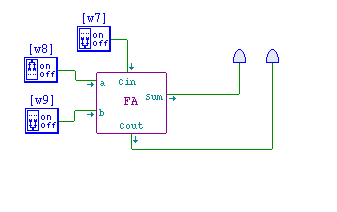
-
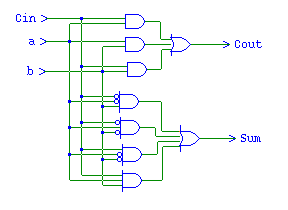
- This is a bit strange, but they proceed to build a 1 bit ALU.
- We need an and and an or.
- Which then requires us to provide a control line to select which output we are interested in.
-
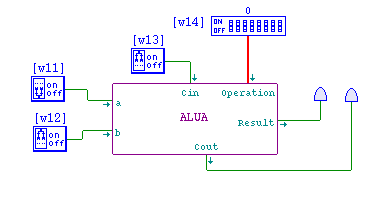
-
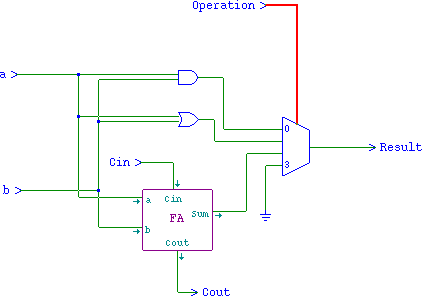
- So we can hook these together to form a (4 bit) ALU.
-
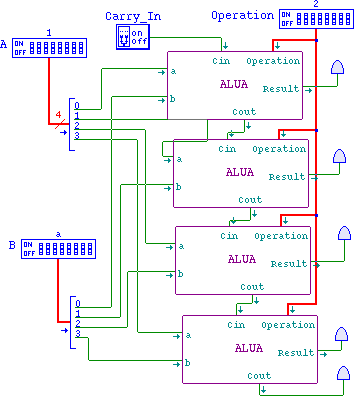
- Show how to and, or , add two numbers with this circuit.
- This will do for addition but what about subtraction.
- Subtraction is just addition by a negative of the number.
- We can take the negative of the number by inverting and adding 1.
- So the following change is in order:
-
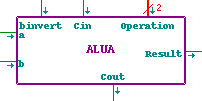
-

- Do a subtract using this circuit.
- Set B_Invert to 1
- Set Carry_In to 1.
- We need a bitwise NOR, which we can form by
- a+b = a · b
- So we need to an an a_invert line, and MUX.
-
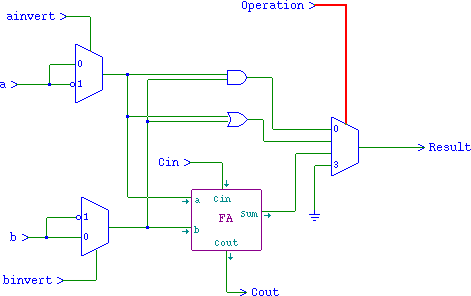
- Next we need to deal with the branch conditions.
- stl $s1, $s2, $s3
- R[rd] = (R[rs] < R[rt]) ? 0: 1
- If R[rs] < R[rt] then R[rd] is set to 1.
- We can just subtract R[rt] form R[rs]
- -3 -(-2) = -1 (the first is smaller)
- 7-8 = -1 (the first is smaller)
- -5 - (-6) = 1 (the second is smaller)
- 4-3 = 1 (the second is smaller)
-
li $t0, n li $t1, m slt $t2, $t1, $t2
- So the sign of the result is 1 is the value we wish to store in the destination register.
- So this is the value we would like to be able to produce from the ALU.
- We will create a new 1 bit alu, ALU0
- Add a new operation (3)
- It is the same as the other ALUs, but
- Add a new input to ALU0 type called less.
- This is piped directly to the third output port on the MUX.
- This needs to be fed the MSB of the sum.
-
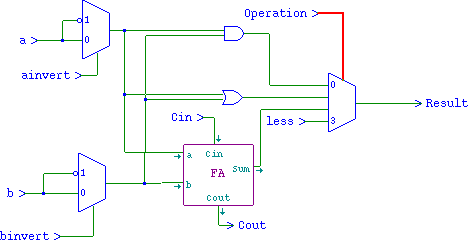
- So we need a new 1 bit ALU for the end of the computation as well.
- Add an output that is the result of the MSB of a sum.
- This gets wired to the less port of ALU0.
-
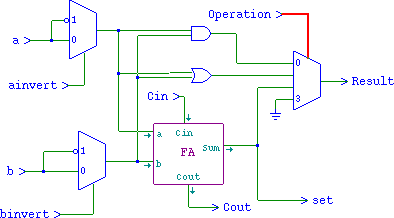
-
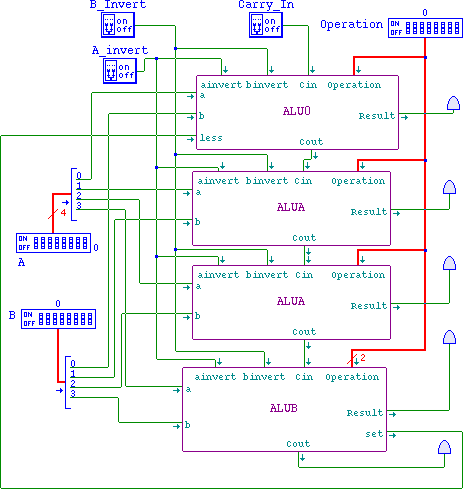
- The final is here
- One last bit... BEQ, BNE
- This is a subtraction.
- If A-B = 0, then there is an equal.
- So we need a way to see if all the bits are 0.
- We can just do a subtraction and put all the result bits into a big OR.
- How do we AND two numbers?
- Place the numbers on A and B
- Set the Operation to be 0
- Set A_invert and B_invert to 0
- Set Carry_In to be 0
- How do we OR two numbers?
- Place the numbers on A and B
- Set the Operation to be 1
- Set A_invert and B_invert to 0
- Set Carry_In to be 0
- How do we NOR two numbers?
- Place the numbers on A and B
- Set the Operation to be 0
- Set A_invert and B_invert to 1
- Set Carry_In to be 0
- How do we add two numbers?
- Place the numbers on A and B
- Set the Operation to be 2
- Set A_invert and B_invert to be 0
- Set Carry_In to be 0
- How do we subtract two numbers?
- Place the numbers on A and B
- Set the Operation to be 2
- Set A_invert to 0
- Set B_invert to be 1
- Set Carry_In to be 1
- How do we slt?
- Place the numbers on A and B
- Set the Operation to be 3
- Set A_invert to 0
- Set B_invert to be 1
- Set Carry_In to be 1